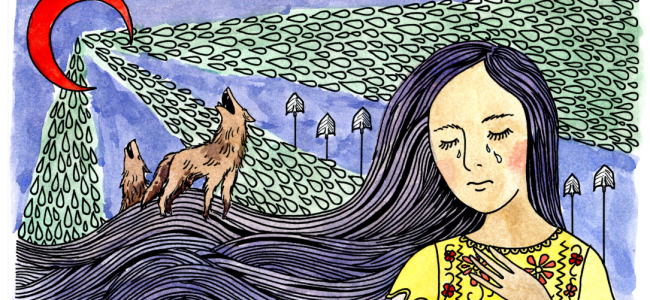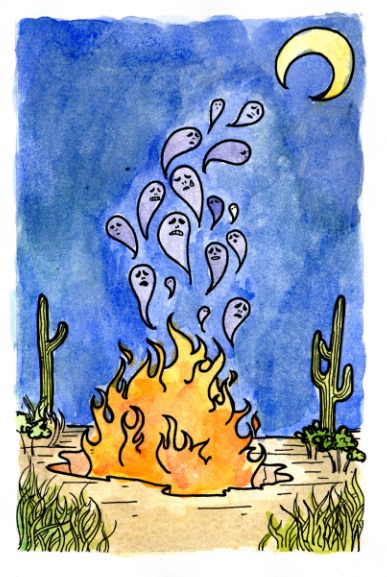
Normalistas, once again

By Alejandra Ibarra Chaoul @luoach
Art by Valeria Pinchuk
On September 26, 2024, the local police in Iguala, Guerrero, Mexico kidnapped and presumably murdered 43 college students who were studying to be schoolteachers. In this story, one-time Rice University exchange student and resident of Mexico City, Alejandra Ibarra Chaoul imagines her grandmother (who is a graduate of the same teaching college from which the missing students were disappeared) learning and reacting to the news of the disappearances.
She picked up the newspaper with tired hands. For the past 90 years, every morning she had been raising her arms to read the newspaper, and for the last 42 days she had been raising them with fear. She was searching for any piece of information that could shed light on the missing normalistas.
With a firm shake of her wrinkled little hands, the paper unraveled itself and the words, printed in grey shades, displayed the news before her eyes. In a press conference, the general prosecutor had given a detailed account —based on the confessions of three recently detained suspects— of how the students had been burnt during the entire night and some hours of the dawn of September 26th and 27th, 2024. She lowered the light paper which now seemed immensely heavy, burdened by the news. The story told by the small letters in the paper seemed so unrealistic.

Years earlier, her aunts had worn their black and white hats while walking the same path she now walked. It was the hats that would make them stand out as young teachers in a post-revolutionary Mexico. The country had torn apart and destroyed almost all the institutions belonging to the era of Porfirio Díaz, the dictator, yet one had prevailed. The model for schools that taught future teachers had been imported from France in 1887. It had survived the violence of war, being able to even keep its name: Normales, which had originally come from norme, the French word for rule.
Many, many years later she would learn that her mother-in-law and her husband’s aunt had also been normalistas. They were the daughters of an accountant and sisters of a baby girl that had died in a wagon during a journey from the north of the country to Mexico City.
Her mother-in-law had been the grandchild of a Porfirian soldier who had lost everything during the Mexican Revolution. Her mother in law had been the first one in her family to study, leaving behind a life of piano lessons, embroidery, and knitting for the promise of a career.
That is how my grandmother walked the streets in 1941: with the weight of history and family tradition upon her. With the hope of Mexico’s growing middle class. With the excitement of being part of the family’s path. With the ideal of being part of the solution for her country. She walked while a changing world failed to notice her.
The world was simultaneously writing the story we would later know as World War II.
She pushed down the power button, clicking the television on. It’s soft light brightened the room. Maybe she could find something about the students there. While absent-mindedly browsing from channel to channel, she thought about the normales rurales (rural schools for teachers). She thought about the girl from the state of Oaxaca who had worked for her. The girl had told her in her thick indigenous accent about her teacher from the mountains: the young man who had taught her how to write and read.
That teacher had left his impoverished home to go to live in the normal rural’s boarding house where he himself would learn Spanish. Later, that young man returned to his community to teach. There, he taught the indigenous girl how to write, read, and even sew.
The little girl’s mother would disappear for days in a row, leaving her behind with her siblings to care for their baby sister, protect her from wild coyotes. Her mom would remain absent for many days — spending the little money they had on booze — and the remainder of them passed out, faded in an alley.
The normalista teacher, meanwhile, would teach the girl how to write, how to read, and how to sew in the rural school in the mountain where she would find refuge for hours.
She turned off the TV, depriving the room of the extra artificial lighting. Annoyed by the trivialization of tragedy, she turned her eyes away from the screen and went back to the paper.
Back then, women studied in the Nacional for young girls, while men lived in a Normal boarding school in Mexico City. President Álvaro Obregón, former general in the Mexican Revolution, had inaugurated the normales rurales in 1921. With time, succeeding governments had started to fear these rural schools, deriding them as communists, chipping away at resources and support and even closing several.
That was why lots of the boys from the Nacional came from Guerrero or Oaxaca. They came to the centralized system in Mexico City to learn so they could return to their communities with the they knowledge acquired. Most of them were indigenous peasants who had nothing left in the world but the broken promise of a failed war for land ownership.
My grandmother and her friends paid little mind to the boys in the Normal. They would have barely seen each other, had it not been for the Agricultural Activities class. There, the men helped the girls soften the soil with their shovels —as if the task that was so hard for the women represented a mere triviality for them.
My grandmother and her friends paid no attention to the boys until they grabbed the microphone. When they did, the girls turned their heads around to see, to stare. The men would talk, from the stand, about their godforsaken communities, about the missing roads, about the isolation and hunger. They would throw their dirt-covered fists in the air cheering for the Communist Party, castigating hegemonic ruling party that wouldn’t do anything to help them out of their historical marginalization. My grandma and her friends would stand there, awestruck, and listen in silence.
After graduating, the girls could pick the school in which they would teach, based on merit valuations. They would all stay within Mexico City. Those with the lowest averages would go to the poorest and peripheral neighborhoods, while the girls with highest grades would be able to choose among renowned neighborhoods.
My grandmother chose to teach in an elementary school named Olavarría. She had started her life as a teacher during the protests organized by railroad workers and medics. Normalistas had always supported social movements, so they joined the demonstrations opposing low salaries, long workdays, and corrupt union leaders. Several teachers, my grandmother included, had ended up barricaded behind the rusty red door of a restroom. They waited there until the banging of the soldiers’ rifles faded out. Years later, my grandfather would remember how his friends and he had seen a group of normalistas running from a pack of soldiers. He remembered how they heard gunshots at the end.
As the years went by the country changed, and so did the education system and its needs. One of her aunts, a well-known normalista, had gone on a government sponsored trip to the USSR. She was supposed to learn the structure of a new learning stage: the kindergartens. A new school for teachers had also been inaugurated, the Normal Superior, which was meant for teachers of junior high. For this new level of education, more specialized classes were required and new professors were hired.
After teaching some years in the Olavarría, my grandmother went back to school. This time she enrolled in the Normal Superior. Some of her new classes were Sociology and Corporatism. They were taught by Spanish republicans, political exiles from Franco who had taken refuge in Mexico. During those years, the student association organized conferences, inviting prominent people to address the students in informal lectures. That’s how she saw and heard first-hand, just a few steps from her chair, the muralists David Alfaro Siqueiros and Diego Rivera avidly criticize the charros (union leaders imposed and controlled by the government).
This time her eyes focused on the ink of a second article in the newspaper. The prosecutor had finished the Q&A section of his press conference saying, “I’ve had enough.” He had had enough of speaking while the entire country heard, holding its breath. He had had enough of not having enough sleep while the parents of 43 missing students had had sleepless nights for over a month. He had had enough of explaining how, probably, 43 normalistas had been burnt by a criminal organization after the mayor of Iguala gave the order to kidnap them.
When she graduated from the Normal Superior she had gone back to teaching. Once she went to the Nacional to visit, but was surprised with what she found. The school now had only two or three groups out of the 10 it had had when she studied there. Eight groups had been closed. The government had reduced the capacity of the school and closed the boarding school for boys all together.
Decades later, she was working in a private school named Héores that had been founded in 1964, when the headmistress and founder called for her. She was a fellow normalista, Eva Sámano Bishop, but was better known for being the first lady: Mrs. Adolfo López Mateos. She asked my grandmother to sit in a meeting she would hold later that day. On that unassuming spring day a group of normalistas rurales from the coastal state of Veracruz were demanding to see the first lady. When they met, the normalistas asked for more resources for their school, for better employment opportunities, and for better salaries.
They hadn’t been the first to make the same demands. In the state of Guerrero, all the way from the Normal of Ayotzinapa, Lucio Cabañas and Genaro Vázquez had started looking for the same rights. They would hold peaceful meetings where they talked in front of normalistas-filled plazas. Cabañas and Vázquez had opted for the guerrilla in 1970 after federal police opened fire against civilians during one of such meetings. Othon Salazar (yet another normalista), on the other hand, had gone to Mexico City after graduating from Ayotzinapa. There he would lead the social fight from the capital of the country.
Railroad workers weren’t the only misrepresented workers. Teachers, too, had union leaders who would “negotiate” salaries on their behalf that couldn’t even buy them a decent meal. Salazar organized the protest against the teachers’ union (SNTE for its Spanish initials) from the poor neighborhood in Fresno where he lived. There, my grandmother and other normalistas would go listen to him speak. Salazar would lecture on the necessary fight for better teachers, better working conditions, and more working benefits.
She lowered the newspaper. She had read all she could find about Ayotzinapa’s normalistas and gazed unimpressed at the rest of the news that seemed so irrelevant. She thought about the first days of 1941, walking to the tram on her way to the Nacional. During those days her mom would stay in the house while dreaming about being a teacher herself. Her aunts would walk the streets with their black hats, and the boys with shovels and dirty hands would speak vibrantly on the stand. The indigenous girl would learn from her beloved rural teacher, and a new social protest would supersede the previous one. She sat there thinking what being a normalista meant.
Closing her eyes, she put away the newspaper that now seemed like the heaviest thing on the world. Forty three normalistas. Forty three missing and probably murdered. Forty three defenseless in the hands of the corrupt local government. Forty three that would be no more. Forty three that, decade after decade, were still vulnerable and had still so many things to fight for. Forty three that would never go back to their communities to teach how to read, write, and even sew. Forty three that would not fill the absence of the state anymore. Forty three teachers working as crèches which would also operate as social services. Forty three normalistas from Ayotzinapa, once again.
Epilogue
Fifty four persons disappear in Mexico per week. In the first two years of Enrique Peña Nieto’s administration, 9,612 people have gone missing. The 43 normalistas from Ayoztinapa are not an isolated tragedy. They are, however, the most recent chapter of a community that has long fought for their rights against political corruption.
Today, December 17th, 2024, 82 days have passed since the normalistas disappeared. The scant traces of remains that were found in garbage bags were sent to Innsbruck, Austria for testing. We have had a single confirmation from the Austrian labs. One molar and a shred of bone were authenticated as the only remains of Alexander Mora Venenancio. It will probably be impossible to know with certainty that the other 42 students died there as well. Since the disappearance of the students, President Enrique Peña Nieto has traveled to China and Australia, but he has still not gone to the state of Guerrero. The president still mispronounces Ayotzinapa, adding an “n” to the end of the word. My grandmother, on the other hand, keeps raising the newspaper everyday to check on any updates.
-
karlitaguanaca







